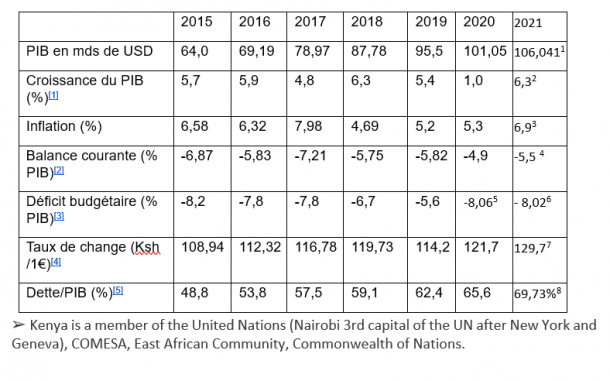Indicateurs économiques


- Since 2014, Kenya has been ranked as a lower middle income country because its per capita GDP crossed a World Bank threshold. The Kenyan middle class continues to grow and is one of the most dynamic in Africa;
- Kenya's economy is the largest in Eastern and Central Africa, with Nairobi serving as a major regional commercial hub. As of 2020, Kenya was the third largest economy in sub - Saharan Africa after Nigeria and South Africa;
- In 2022, Kenya’s economic growth averaged 6%, placing Kenya as one of the fastest growing economies in Sub-Saharan Africa;
- In 2020, Kenya ranked 56th in the World Bank ease of doing business rating, up from 61st in 2019 (of 190 countries);
- Kenya is the gateway to Eastern and Central Africa regions. Her developed infrastructure and membership in the East African Community (EAC) with over 140million people and Common Market for Eastern and Southern Africa (COMESA) with over 400million people make Kenya the ultimate trade and investment destination;
- Kenya is also the largest and most advanced economy in East and Central Africa. Its GDP accounts for more than 45 per cent of the region’s total.

Kenya Exports and Imports
- Almost 65 percent of all export earnings are from agriculture, with tea, coffee, and horticultural products.
- Kenya major Imports that account for 36% include: machinery and transportation equipment, petroleum products and motor vehicles.

Trade relations with Belgium
- Kenya maintains cordial bilateral relations with Belgium, the substance of which is mainly economic. Belgium does not project a particular image to Kenya. Kenya was our country's 12th African customer in 2020 (69th worldwide) and the 19th African customer in 2021 (87th worldwide). The trade balance amounted to + 143.6 million euros for Belgium.
- In 2020, Belgium exports to Kenya largely mineral products (almost exclusively petroleum oils or bituminous minerals) and chemicals (mainly vaccines, antisera & drugs presented in the form of doses). As for Belgian imports from this country in 2020, they focus on plant products (9 million euros: coffee, leguminous vegetables,etc.) and products from the food industries (non-frozen vegetable preparations and fruit preparations, edible parts of plants, etc.).
